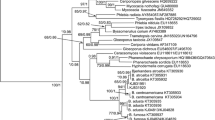Abstract
Ochropsora ariae was found to host-alternate between Anemone pseudo-altaica and Aruncus dioicus var. tenuifolius and Ochropsora nambuana between Anemone flaccida and Elaeagnus multiflora var. hortensis in Japan. Both species produced a sessile, thin-walled, cylindrical probasidium (teliospore), which turned into a four-celled metabasidium by continuous apical elongation of the probasidium. Several probasidia of O. nambuana were produced from a basal basidiogenous cell in a sorus hymenium. Life cycle and probasidium/metabasidium morphology showed the taxonomic identity of Ceraceopsora elaeagni with O. nambuana. Developmental morphology of the basidium found in the two Ochropsora species raised a question against the taxonomic separation of Ochropsora and Aplopsora.
Similar content being viewed by others
References
GB Cummins Y Hiratsuka (1983) Illustrated genera of rust fungi, revised edition American Phytopathological Society St. Paul, MN
GB Cummins Y Hiratsuka (2003) Illustrated genera of rust fungi EditionNumber3rd ed American Phytopathological Society St. Paul, MN
P Dietel (1895) ArticleTitle Ochropsora, ein neue Uredineengattung Ber Dtsch Bot Ges 13 401–402
Fischer E (1904) Die Uredineen der Schweiz. Beiträge zur Kryptogamenflora der Schweiz. Bd 2 Heft 2
E Fischer (1910) ArticleTitleBeiträge zur Entwicklungsgeschichte der Uredineen Centralbl Bacteriol II Abt 28 139–152
L Fuckel (1869) ArticleTitleSymbolae mycologicae. Bieträge zur Kenntniß der Rheinischen Pilze Jahrb Nassauisch Ver Nat 23-24 1–459
Gäumann E (1959) Die Rostpilze Mitteleuropas. Beiträge zur Kryptogamenflora der Schweitz 12:7–1407. Buchdruckerei Buchler, Bern
JA Hart (1988) ArticleTitleRust fungi and host plant coevolution: do primitive hosts harbor primitive parasites? Cladistics 4 339–366 Occurrence Handle10.1111/j.1096-0031.1988.tb00519.x
N Hiratsuka S Kaneko (1978) ArticleTitleHeteroecism of the Wistaria rust, Ochropsora kraunhiae (Diet.) Dietel Rep Tottori Mycol Inst 6 300–303
N Hiratsuka S Sato K Katsuya M Kakishima Y Hiratsuka S Kaneko Y Ono T Sato Y Harada T Hiratsuka K Nakayama (1992) The rust flora of Japan Tsukuba-shuppankai Tsukuba
S Ito (1938) Mycological flora of Japan (in Japanese) Yokendo Tokyo
M Kakishima S Sato (1984) ArticleTitleInoculations and morphology of Ceraceopsora elaeagni Rep Tottori Mycol Inst 22 171–178
M Kakishima T Sato S Sato (1984) ArticleTitle Ceraceopsora, a new genus of Uredinales from Japan Mycologia 76 969–974
H Klebahn (1907) ArticleTitleKulturversuche mit Rostpilzen Z Pflanzenkr 17 129–157
Ono Y (1978) Taxonomic revisions of the tribe Oliveae morphologically related genera (Uredinales). Ph. D. thesis Purdue University, West Lafayette, IN
Y Ono (1984) ArticleTitleTaxonomy of rust genera formerly classified in the tribe Oliveae Rep Tottori Mycol Inst 22 186–190
Y Ono (1995a) ArticleTitleLife cycle of Cerotelium asari (Uredinales) Sydowia 47 54–64
Y Ono (1995b) ArticleTitle Aecidium alangii is the aecial state of Puccinia miyakei (Uredinales) Nova Hedwigia 60 157–164
Y Ono (2002) ArticleTitleThe diversity of nuclear cycle in microcyclic rust fungi (Uredinales) and its ecological and evolutionary implications Mycoscience 43 421–439 Occurrence Handle10.1007/s102670200062
Y Ono ZM Azbukina (1997) ArticleTitleHeteroecious life cycle of two graminicolous Puccinia (Uredinales) Mycoscience 38 281–286
Y Ono P Buriticá JF Hennen (1992) ArticleTitleDelimitation of Phakopsora, Physopella and Cerotelium and their species on Leguminosae Mycol Res 96 825–850 Occurrence Handle10.1016/S0953-7562(09)81029-0
Y Ono Y Harada (1994) ArticleTitle Aplopsora corni sp. nov. on Cornus controversa from Hokkaido Japan Mycoscience 35 179–181 Occurrence Handle10.1007/BF02318497
Y Ono JF Hennen (1983) ArticleTitleTaxonomy of the chaconiaceous genera (Uredinales) Trans Mycol Soc Jpn 24 369–402
J Ramsbottom (1914) ArticleTitleNote on the nomenclature of some rusts Trans Br Mycol Soc 4 331–340 Occurrence Handle10.1016/S0007-1536(12)80036-2
T-F Soong (1939) ArticleTitleBeitrag zur Cytologie der Uredinee Ochropsora Sorbi Diet Flora 133 345–364
Savulescu T (1953) Monografia Uredinalelor din Republica Populara Romana. Bukarest
P Sydow H Sydow (1915) Monographia Uredinearum, vol 3 Fratres Borntraeger Lipsiae
W Tranzschel (1904) ArticleTitleNeue Fälle von Heteröcie bei den Uredineen Trav Mus Bot Acad Imp Sci St Pétersb 2 14–30
M Wilson DM Henderson (1966) British rust fungi Cambridge University Press London
G Winter (1884) Die Pilze L Rabenhorst (Eds) Kryptogamen-Flora von Deutschland, Oesterreich und der Schweiz 2 Aufl Verlag von Eduard Kummer Leipzig 132–270
Author information
Authors and Affiliations
Corresponding author
About this article
Cite this article
Ono, Y. Taxonomic implications of life cycle and basidium morphology of Ochropsora ariae and O. nambuana (Uredinales). Mycoscience 47, 145–151 (2006). https://doi.org/10.1007/s10267-006-0285-9
Received:
Accepted:
Issue Date:
DOI: https://doi.org/10.1007/s10267-006-0285-9




